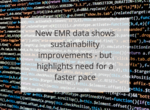Latest EMR data released
14th May 2020
The Higher Education Statistics Agency (HESA) has released the
latest Estates Management Record (EMR) today (Thursday, 14th May).
These environment statistics are some of the most useful and telling when it comes to assessing where the Higher Education sector is with sustainable development and emissions reduction.
EAUC has been vocal in its concern about the EMR data losing its mandate for English institutions, and we were keen to see if this would make a difference in the number of institutions that submitted EMR data this year (the first without the mandate). We are incredibly pleased to see that this has not had a huge impact, and despite difficult circumstances, all institutions but one were able to submit their EMR data for 2018/2019.
This is testament to a sector that is taking sustainability incredibly seriously, and leading the charge towards Net Zero. The data itself is also interesting, despite a sizable increase in total site area and an incremental increase in buildings owned by the Higher Education sector, there have been improvements in all of the areas we would want to see from a progressive sector. That being said, it is questionable whether this progress is enough to keep the sector as a whole on track to meet net zero targets by 2050 at the latest. We will work with the wider sector on this.
The one institution unable to provide its EMR data due to COVID-19 is a sizable one (University of Birmingham) and as such, the lack of its data does have a relatively significant impact on the figures. But we can still see consumption of energy and water are down, scope 1 and 2 emissions are down, renewable energy generated on campuses is up, as is the amount of energy campuses export to the grid.
There is also an emerging good news story around travel and transport in the data. Total fuel used in HE owned vehicles is down by around 7%, and the number of carpark spaces, which has been on an upward trajectory since this data began, has had a turn around this year and started to decrease. Meanwhile cycle spaces in the sector continue to rise.
There has certainly be a discernible change in the mindset of the sector over the last year.
The Climate Commission for UK Higher and Further Education Students and Leaders, a partnership between Association of Colleges, EAUC, GuildHE and Universities UK, has gone from strength to strength. This drive comes from the sector – also demonstrated by the ambitious
Net Zero targets institutions have been making, and the growing number of institutions that have announced divestment and ethical financing policies. We hope this represents a gearshift and look forward to seeing further and greater reductions in the years to come.
As ever, there is still much more to do in the sector to meet Net Zero targets and slow global warming – the pandemic we currently face is a tragic reminder of what can happen if we are not prepared for global crises. We will support the sector to build back better from the pandemic, ensuring sustainability is at the heart of a just, clean and smart recovery. If we learn nothing else from the painful lesson of the Covid-19 crisis, it is that education and health and wellbeing must be at the forefront of plans to tackle the Climate Crisis.
In the 2019/2020 EMR data, we can expect to see serious skewing due to the impact of the pandemic on campuses. We already know energy consumption and emissions are much lower than they usually would be this time of year. But the following year's data is the true test. Who will be able to maintain some of the huge scale changes brought about by the pandemic? Which institution will make the most of this awful situation, and completely rethink its working to ensure a green recovery?
The EMR data is essential in ensuring the sector is being held accountable for its actions towards emissions reduction and sustainable development and being transparent with both their staff and students. We thank HESA for its continued facilitation and analysis of the EMR data and will continue to work with HESA in developing robust Scope 3 data for the sector. We will continue to lobby OfS to expand its support for the sector in England to ensure it reaches Net Zero as quickly as possible.
NOTE: The table below is a summary of the information on the data release. It is important to note that some of the data is skewed by missing institution's data, which is a large institution. We will update these figures if they submit their EMR data. Otherwise, it would be fair to remove them from the
previous data set for better comparability. We will look at doing this, but presently, the raw data is below.
| |
2017/18 |
2018/2019 |
Up/Down |
| How many reported? |
160 |
159 |
Down 1 |
| Total number of buildings |
16250 |
16271 |
Up 0.1% |
| Total site area (hectares) |
11307 |
12456
|
Up 9.5% |
| Total energy consumption (KwH) |
7,802,295,084 |
7,416,240,232
|
Down 4.9% |
| Total generation of electricity exported to the grid (KwH) |
3235407.07 |
3500439.22
|
Up 8% |
| Total fuel used in HE provider owned vehicles (litres) |
5,260,472.34 |
4,899,791.66
|
Down 6.8% |
| Total renewable energy generated onsite or offsite (kWh) |
40,952,423.62 |
44,307,839.90
|
Up 8.1% |
| Total water consumption (m3) |
24,945,798.62 |
24,013,379.21
|
Down 3.7% |
| Total volume of waste water (m3) |
22,841,127.75 |
21,746,370.06
|
Down 4.7% |
| Total scope 1 and 2 carbon emissions (Kg CO2e) |
1782203858 |
1,634,903,244.17
|
Down 8.2% |
| Total waste mass (tonnes) |
416081.701 |
511069.4
|
This statistic needs checking as there is a particularly anomalous figure. |
| Total number of car parking space |
188,827 |
180,558 |
Down 4.3% |
| Total number of cycle spaces |
143,770 |
145,703 |
Up 1.3% |






 Except where otherwise stated, content on this site is
licensed under a Creative Commons Attribution 3.0 License.
Except where otherwise stated, content on this site is
licensed under a Creative Commons Attribution 3.0 License.
